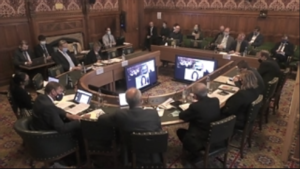
Earlier this year the Environmental Audit Committee published a Call for Evidence on how best to reach ‘net zero’ in our built environment. They received 140 written responses, including two from members of the Design group, Alice Moncaster and Jane Anderson. Both were also invited to give evidence in person (virtually), Jane on 14th July and Alice on 20th October.
What is the Inquiry all about?
It’s well known that the built environment is responsible for about 39% of global carbon emissions. However it is less well known that this figure has two very distinct sections: the construction of the built environment is responsible for 11% of these emissions, while the energy used for heating, lighting and cooling our existing buildings is responsible for the other 28%. We all live, work, shop and go to school in buildings, so in many ways it’s not surprising that a big percentage of our energy use goes into making those spaces more comfortable. But that doesn’t mean that we can’t reduce those emissions – we certainly can, and are doing so, through improved insulation levels and more airtight construction. A key focus of the building regulations for many years, for Governments across the world, has been on increasing energy efficiency of (new) buildings. Increasingly we are starting to look at how to radically retrofit existing buildings to reduce their energy use too.
In most of Europe and the UK, construction is responsible for around 9% of our national emissions – this is lower than the global average, and compares with China for which construction is around 16% of their carbon emissions. However this is still a higher percentage even than flying (7.5%). Given that in this country we add only around 1% to our built environment each year, the fact that the construction of this 1% (plus a little bit on refurbishing and demolition) costs the 9% of our carbon budget shows what huge impacts construction materials and processes have.
Why isn’t anything being done about it?
Well, with the EAC Inquiry it seems as if at last something is being done. Many of us have been researching this area of embodied carbon of buildings for years. There are now countless case studies of individual buildings. International standards have existed since 2011 to calculate the carbon impact of individual building products and materials, and the embodied carbon of a building through its life. Industry groups have even started lobbying for the inclusion of embodied carbon in building regulations. In the UK, the methodology has been further developed as a Professional Statement by the Royal Institution of Chartered Surveyors (RICS) in 2017 – a project which Alice and Jane were also both involved in – and this is starting to be used widely but on a voluntary basis. Some other European countries have started to introduce regulations. The UK Government are now starting to take note, and embodied carbon is a key element of this Environmental Audit Committee Inquiry.
Who are the OU experts in this area?
Dr Alice Moncaster is an expert in environmental impacts of buildings. Since 2011 she has been the UK expert on two International Energy Agency Annexes (Annex 57 and Annex 72) on embodied and whole life carbon and energy of buildings, and was the academic partner in the development of the 2017 RICS professional statement. Jane Anderson is an expert in environmental impacts of construction materials. She was the author of several of the BRE Green Guides to Specification from 1998-2010, and is the UK expert on the European (CEN) and international (ISO) standards bodies who have developed the current standards. She is currently undertaking a PhD with Dr Moncaster at the OU. She was responding to the Inquiry on behalf of the Alliance for Sustainable Building Products (ASBP) where she is a Board member.
Alice’s written evidence can be found here, and Jane’s can be found here, and here.
This article has been updated on 17th November. The third session of oral evidence is being heard this afternoon, with experts from Cambridge University, the IStructE and others due to answer questions from the committee.

Leave a Reply